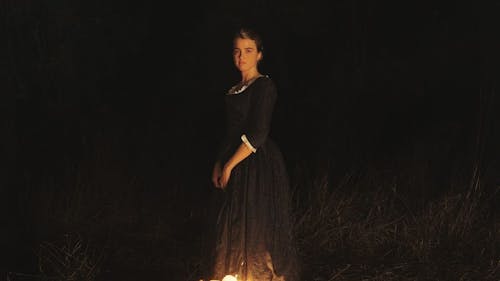BENITEZ: Female gaze does not exist
Column: Hear Me Out

In the vast landscape of contemporary discussions on gender, the term "female gaze" has emerged as a compelling and frequently debated topic.
Yet, in our exploration of this subject, a pertinent reality often gets overlooked — the female gaze is not a concrete entity. It lacks the scholarly analysis and theoretical foundation. Instead, we find ourselves in a paradoxical situation where a term meant to challenge norms has been normalized, even though it reinforces the stereotypes it is trying to fight.
We hear about the male gaze all the time. Movies, books and advertising are all defined by what the men want. The term itself was introduced by Laura Mulvey, a feminist film theorist, in her influential essay titled "Visual Pleasure and Narrative Cinema," published in 1975.
In her essay, Mulvey argued that mainstream cinema works under a male-dominated perspective, both in terms of production and consumption. She highlighted three main aspects of the male gaze: the objectification of women, power dynamics and narrative structure. The last one explains the narrative structure in movies, which often reinforces the male protagonist's point of view, with female characters serving as catalysts for male desire or obstacles to be overcome.
We see it clearly in almost every piece of media.
Objectification is like Pamela Anderson in "Baywatch," Meghan Fox in "Transformers" and every woman who appears to be there for their body. Power dynamics such as a CEO always being a man with a woman as an assistant, a dad being a family’s decision-maker and every other small detail reinforces that men are in power — as well as narrative structures with women as a secondary thing, just like in almost every movie made until the 2000s.
After the fourth wave of feminism in the 2010s, with the rise of social media, more multifaceted subjects, such as the male gaze, came to be more heavily discussed. And as of recently, derived from Mulvey’s theory, the term "female gaze."
The female gaze is a freshly new subject. It does not have a single point of origin, yet it has been discussed in a scholarly manner. It offers an alternative to the male-centric perspective that has historically dominated art, literature, film and other forms of media. This new perspective attempts to present a more nuanced and authentic portrayal of women, challenging traditional stereotypes and objectification.
Nevertheless, even with the efforts of the feminist movement and scholars that investigate gender theories such as this one, the female gaze is not an actual thing.
Do not get me wrong — I would love more than anything to be wrong. But the more I investigate it, the more I understand the phrase "the world was made for men." Proponents often argue that the female gaze portrays women as active observers, emphasizing emotion and sensibility over objectification. Even though it sounds like a noble notion, it is filled with the potential for negativity.
Emma Syea said it perfectly in her article, "The False Freedom of the Female Gaze."
"The idea that women are 'better' at emotions, that they are more sensitive, compassionate, and caring has long been propagated as a gender stereotype — and one which historically has ensured that women have been limited to the roles of nurturers, supporters, and facilitators," she said.
Adding to that, connecting the female gaze to a more "sensible" view denies the existence of women who do not fit this mold, and it overlooks the diversity of female experiences and perspectives.
Another issue with the female gaze is the fact that it perpetuates the idea that women do not objectify other women. For instance, Céline Sciamma’s 2019 film "A Portrait of a Lady on Fire," starring Adèle Haenel as Héloïse, has been called a "manifesto" of the female gaze by the director herself. It has also been praised for the way it avoids crass objectification.
Nonetheless, "pretending that women do not ever engage in objectification themselves not only seems strangely prudish but also works to reinforce gender stereotypes," said Syea. It perpetuates the idea that women do not want men the way men want women and that they need a more emotional connection.
This places constraints on women's sexuality. Generalizing women's desires and the way they think about sex is just another way of suppressing them.
In trying to distance themselves as much as possible from the male gaze by portraying movies through the female gaze, filmmakers walk on a thin wire of reinforcing stereotypes.
There are several other issues with the female gaze and its meaning, but the overall conclusion is that the term is meaningless. The male gaze exists because it supports the ideology of the people in power.
Even though the world is very different than it was 100 years ago, women are still not in power. Trying to create something through a lens that shows women’s perspectives is thereby impossible.
It is necessary to get as far as possible from the male gaze and what it implies. We need to battle objectification and the negative portrayals of women by being aware of its presence, participating in discussions and supporting artists that go against it.
But creating an opposite binary term with a loose meaning just opens doors to critique, a flawed theory and the opportunity for people to take whatever they want and run with it.
As we analyze the female gaze, it becomes evident that the very act of defining and conceptualizing it perpetuates a cycle deeply rooted in the male gaze. Despite our efforts to liberate ourselves from the constraints of a male-centric worldview, we inadvertently find remnants of its influence lingering in the shadows.
While dealing with these complexities, it becomes increasingly apparent that the idea of the female gaze, while commendable, remains entwined with the very system it seeks to dismantle. We need to acknowledge that true liberation requires a fundamental reimagining of the entire gaze itself.
Marina Benitez is a School of Arts and Sciences senior majoring in journalism and media studies and minoring in gender and media. Her column, "Hear me out," runs on alternate Mondays.
*Columns, cartoons and letters do not necessarily reflect the views of the Targum Publishing Company or its staff.
YOUR VOICE | The Daily Targum welcomes submissions from all readers. Due to space limitations in our print newspaper, letters to the editor must not exceed 500 words. Guest columns and commentaries must be between 700 and 850 words. All authors must include their name, phone number, class year and college affiliation or department to be considered for publication. Please submit via email to oped@dailytargum.com by 4 p.m. to be considered for the following day's publication. Columns, cartoons and letters do not necessarily reflect the views of the Targum Publishing Company or its staff.



